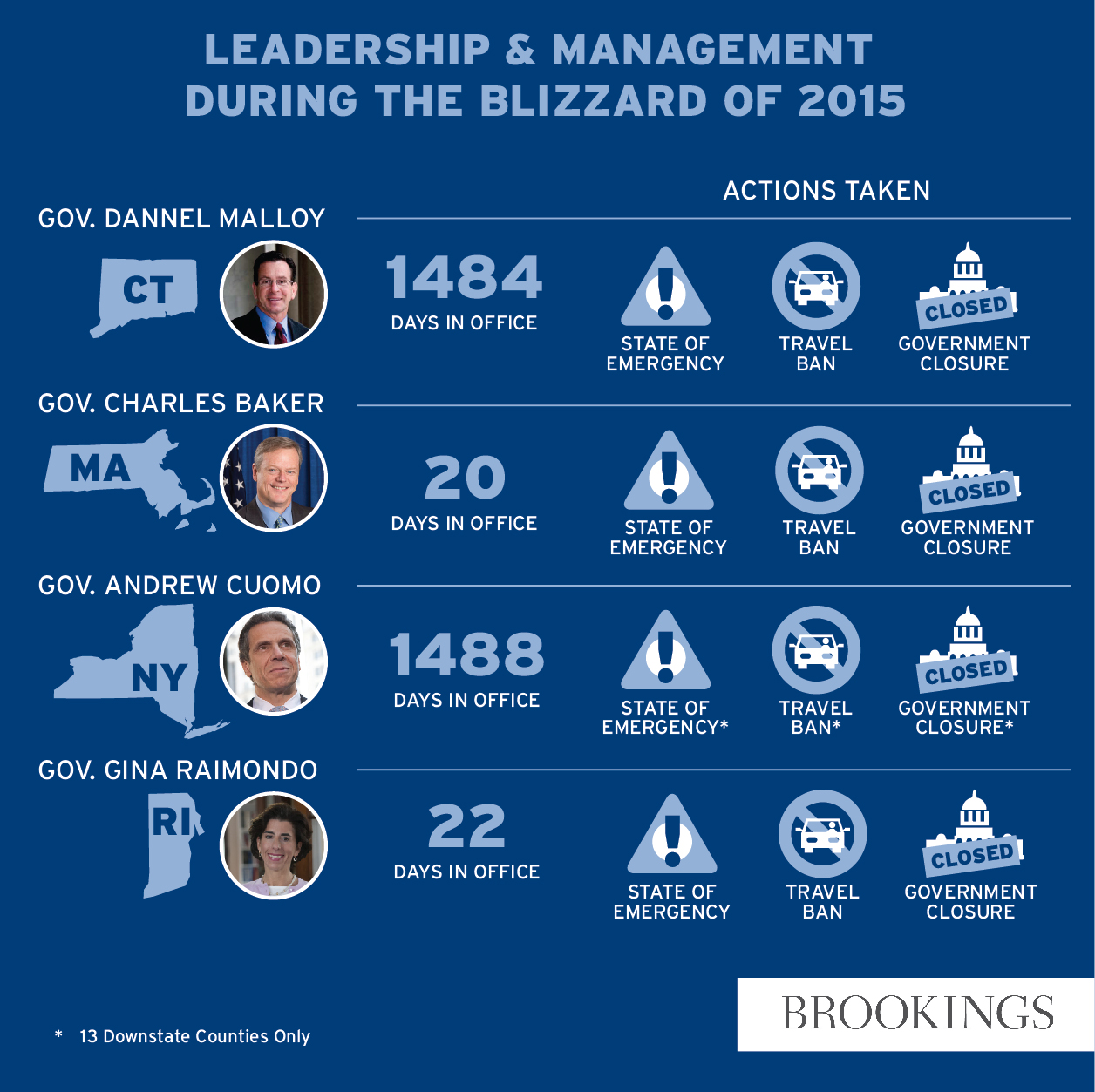The “Blizzard of 2015” illustrated public management at its finest, and in a time when citizens lament a broken government, this natural disaster shows that government can work. As an historic storm battered the northeast United States with snow measured in feet, winds at hurricane strength, government went to work.
It is perhaps ironic that government works best in the face of disaster—when society grinds to a halt, but governors across the region put to work emergency preparedness plans, teams of employees, and state-sanctioned powers to respond.

Some of the most major actions governors can take in the face of such natural disasters include emergency declarations, closure of state offices, suspension of mass transit, and travel bans—essentially closing all roads in a state or portion of a state. The table above highlights four of the several states impacted by this powerful storm and the manner in which state leadership has responded.
These four states present interesting cases. Connecticut and New York have governors recently sworn into their second terms, having now served nearly 1500 days each in office and with substantial experience dealing with natural disasters. Govs. Malloy (CT) and Cuomo (NY) have overseen debilitating snowstorms, deadly icing events, and multiple hurricanes including Superstorm Sandy.
Massachusetts and Rhode Island are different. Their governors, Charlie Baker (MA) and Gina Raimondo (RI), have combined gubernatorial service of 42 days, each having been sworn in just weeks ago. While they have endured harsh New England winters and serious weather events, they have not faced such challenges at the helm of a state government.
Despite differences in experience and in background, despite hailing from different parties, despite serving populations and geographic areas large and small, these governors responded in similar, effective ways. Each declared a state of emergency, providing each governor additional powers and positioning each state to qualify for FEMA disaster relief. Each enacted travel bans, effectively barring citizens from use of roads in ways that assist public works crews and first responders. Where necessary, mass transit was suspended. Major airports including Boston’s Logan and Hartford’s Bradley suspended air traffic. State offices were closed. Governors encouraged businesses to close in order for citizens to comply with travel bans.
In advance of the storm, state and municipal emergency operation centers were activated and opened, as leaders understood they faced tremendous tasks.
The result was not our normal view of government or of bureaucracy or of leaders. We did not see partisan bickering; we did not see bureaucracy slow to move; we did not see leaders hide from the public. We saw government work, and a public place its trust in that government.
We saw leaders base decisions on up-to-date, accurate information, and disseminate that information across the many levels of government. We saw agencies work together and communicate with each other and the public.
Governors across each state used mainstream and social media to communicate with the public to ready them for the blizzard and to keep them informed. Radio and TV news and print media offered updates from press conferences and briefings. Social media, a particularly reliable source of up-to-the-minute information, has become a true asset during emergencies.
In Connecticut, Gov. Malloy tweeted about coordination efforts between state and municipal governments.
We’re on a statewide call with municipal leaders right now to discuss storm preps for each town and city across #CT
— Governor Dan Malloy (@GovMalloyOffice) January 26, 2015
In Massachusetts, Gov. Baker, in coordination with the state emergency management agency, tweeted about the state’s most impactful actions.
From @MassEMA, announcing a state of emergency effective now & a statewide travel ban starting at midnight in preparation for the blizzard.
— Charlie Baker (@MassGovernor) January 26, 2015
In New York, Gov. Cuomo used Twitter to point New Yorkers to a one-stop shop for all emergency information related to the storm.
Check http://t.co/FsHbDTXlAs for official, consolidated emergency alerts, transit closures and more. pic.twitter.com/10C6Lc2Oji #blizzardof2015
— Andrew Cuomo (@NYGovCuomo) January 26, 2015
In Rhode Island, Gov. Raimondo tweeted one of her first executive orders, a emergency declaration for the state.
I have signed an executive order issuing a State of Emergency for RI. http://t.co/uY2x1ykubx #JunoRI pic.twitter.com/NM5hq689FX
— Gina Raimondo (@GinaRaimondo) January 26, 2015
Government coordination extended beyond the actions of governors. FEMA’s Region I and II—those hardest hit by this storm—communicated and coordinated both with their central command as well as their emergency management partners across states and municipalities, keeping leaders and citizens informed and better prepared. State and local officials, in press conferences, noted they were in frequent communication with the local offices of the National Weather Service to get accurate, real-time information that could be delivered to residents.
The “Blizzard of 2015” surely brought havoc for tens of millions of Americans as it blanketed the nation’s most populated geographic corridor with 1’-3’ of snow. However, it also illustrated that government can be effective. Multiple government agencies at the federal, state, and local levels can communicate, share information, coordinate activities, and work together.
The decisions that federal, state, and local leaders have made over the past few days will have varied. Some may look as if they overreacted as forecasts changed. Others will have made a few mistakes along the way. Still others will come out of crisis looking strong and prepared. Regardless, the effectiveness of public and emergency management efforts will have saved lives (a number impossible to calculate), helped road crews (at a pace that is difficult to measure), built experience and provided lessons that will be used for future disasters—the rare events when public expectations of their government are actually met.
*Grace Wallack, Curtlyn Kramer and Em Parsons contributed to this post.



Commentary
How the Blizzard of 2015 Shows Us Government Can Work Well
January 27, 2015